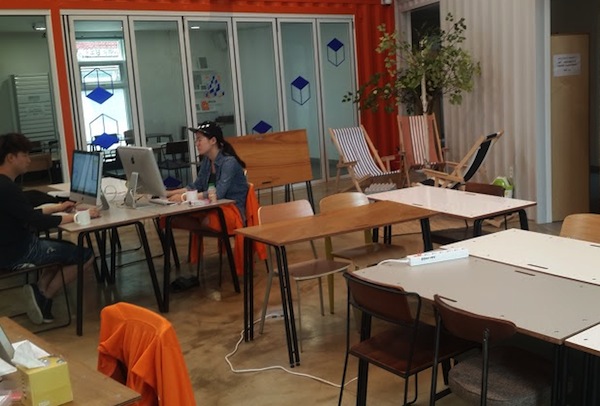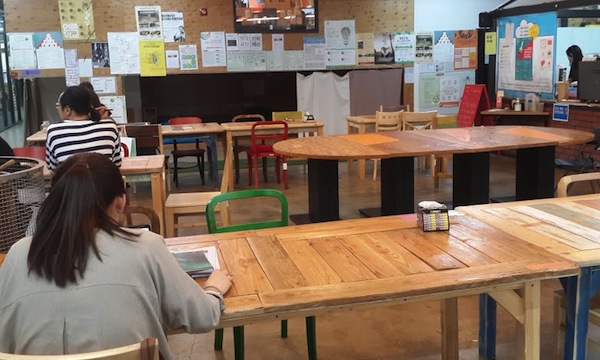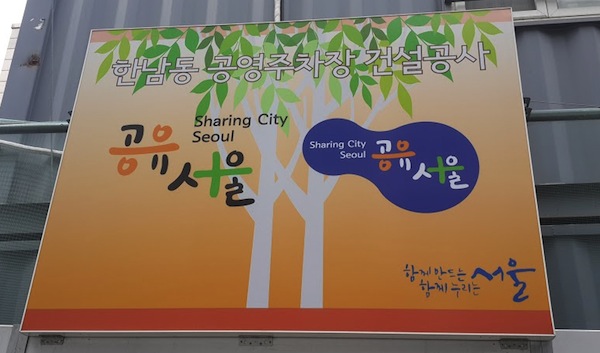Editor’s note: Monica Bernardi is an urban sociologist and a PhD candidate in “Quality of Life in the Information Society” at the Milano-Bicocca University (Italy). Her research focuses on sharing cities and the governance model implemented in order to support the practices and services of the sharing economy in cities.
*************************************************************************************************************************
Please share with Shareable. DONATE today to support our ad-free coverage of the real sharing economy
*************************************************************************************************************************
For several years, Shareable has followed, and reported on, Sharing City Seoul, a pioneering project, created by the Seoul Metropolitan Government. With its government-sponsored sharing economy initiatives and community projects, Seoul has become a global leader in the sharing cities movement.
Recently, Shareable connected with urban sociologist Monica Bernardi, who recently visited Seoul for her research on sharing cities, to learn more about how Sharing City Seoul exists within the high-tech mega city of Seoul, and what that looks like from an on-the-ground perspective.
Shareable: What are your impressions of Seoul as a high-tech city?
 Monica Bernardi: Seoul is an incredible, modern city. It is efficient and always clean, and infrastructures of the latest generation go with citizens in their everyday life, making every movement, gathering and event easier and pleasant—even if the metropolitan area counts 25.6 million inhabitants, and traffic, congestion and pollution cannot be forgotten.
Monica Bernardi: Seoul is an incredible, modern city. It is efficient and always clean, and infrastructures of the latest generation go with citizens in their everyday life, making every movement, gathering and event easier and pleasant—even if the metropolitan area counts 25.6 million inhabitants, and traffic, congestion and pollution cannot be forgotten.
The skyline of the city is sprinkled by vertiginous skyscrapers and the offices of global corporations such as Samsung, LG, and Hyundai-Kia. Seoul is at the top level of technological maturity and has the densest public transport infrastructure in the world. The city is served by high-speed train KTX, and has the longest underground network in the world, enriched with 4G LTE connection, WiFi and Digital Multimedia Broadcasting (DMB).
Seoul is a true next-generation, IT mega-city that is the pride and the flagship of a nation with the highest amount of available WiFi locations worldwide as well as the highest average speed of connection in the world. The country’s highly developed digital infrastructure is due to government-established policies and programs which enabled the nation-wide adoption of broadband internet as the subsequent development of wireless broadband technologies.
Seoul is one of the most technologically advanced cities in the world. How does the sharing economy exist within such developed infrastructure?
The city can look like a real Smart City, focused on technologies and forgetting people and the human dimension. On the contrary, the technological equipment is not considered the final purpose, but simply an enabling factor—a tool to improve the life quality of the citizens, especially during the current administration.
One of the main slogans of the Mayor Park Won-Soon is “making Seoul a city for the citizens and by the citizens,” a catchphrase for getting the citizens included as priorities in his administration and the governance of Seoul. The city agenda switched from an economy-centered development agenda to a people-centered living welfare agenda thanks to the pro-people mayor, who has more than 30 years of human rights activism experience.

The Seoul Youth Zone is a space for young people to generate ideas and projects. Under Mayor Park Won-Soon's administration, technology in Seoul is considered a tool to improve the lives of citizens.
As Shareable has reported, Seoul Metropolitan Government (SMG) prioritizes creating a sharing ecosystem in the city to address the social, environmental, and economic issues facing Seoul. How are they integrating sharing into the city’s tech culture?
The idea to foster the disruptive innovations of the sharing and collaborative economy comes from the awareness that a city with a high level of urbanization and industrialization, high density, a strong air pollution and weak social ties, needs new alternative answers to address the urban challenges. The high penetration of IT services and social networks has naturally led to the identification of the sharing economy as an intervention strategy, facilitating the adoption and dissemination of sharing and collaboration practices and encouraging the development of projects and business associated with them.
In general we can detect two types of sharing economies in Seoul: that of multinational corporations, such as Uber and Airbnb (even if for many experts they cannot be considered sharing economies, but rather rental economies), and another type of sharing economy more oriented to the small local scale and largely supported by SMG.
How do the two types of sharing economies exist in Seoul on a day-to-day basis?
About the first type, Airbnb is the only big company thriving in Korea. It is taking advantage of the governmental policies and initiatives related to the sharing economy, and is flourishing in the city. The unexpected success of Airbnb in South Korea put Seoul on the list of cities with the most listings, alongside San Francisco, London, and Paris. There aren’t official statistics on the Airbnb business on South Korea but is evident that the company has a big presence in terms of local marketing and branding.
Understanding the power of this Airbnb model, local solutions are flourishing. There are entities offering short terms rental vacation solutions and opportunities to experience life in a typical Korean house (Hanok) and savor the local culture and traditions, with platforms including Kozaza and BnBHero. These solutions are very similar to Airbnb but with a local imprinting that reveals the general will of the city to not be bulldozed by the big sharing companies. Another interesting case is that of UBER X being banned from the city and replaced by new local solutions.
The second type of sharing economy in Seoul gives official support for tech startups and other organizations that work to catalyze more sharing in Seoul and are able to solve social local problems. The city is looking to the providers of services first, involving them in the project in order to create the right offer and the proper environment to favor the adoption of these services and practices by citizens. In the meantime it is working to pave the way and strengthen the ecosystem for the sharing economy to thrive by spreading the knowledge about the sharing and collaborative services through promotion, events, sharing schools, public campaign, and a Sharing City Seoul logo.

Metropolitian Seoul, which is home to 25 million people, boasts the most WiFi locations in the world, the highest average speed of connection, and the longest underground public transport network in the world.
Sharing City Seoul is designed to include all Seoul citizens—not just those with smartphones. What evidence of this do you see in the city?
At first glimpse it seems that SMG is building an interwoven structure able to cover different social fields and to reply to the needs of many targets of people, such as housewives, children, freelancers, retirees, social entrepreneurs, creatives, social innovators, etc. Mayor Park has a distinct inclination to the human dimension, and points to a real paradigm shift that affects the daily lives of its citizens.
Further evidence of this inclination is also the creation of Citizens Hall, an open, shared space in Seoul City Hall to help citizens discuss issues, make proposals, and find gatherings and sharing opportunities. It’s a venue for a multitude of citizen-oriented events and activities, such as performances, exhibitions, forums, lectures, and markets, and a space for policy forums and citizenship education courses. It is also a place where learning and communication activities are conducted every day in order to empathize with the citizens and hear their opinions. A space of the people, for the people and by the people.
The propensity of SMG to support ideas and social businesses involved in sharing economy services and initiatives is generating a strong wave of social innovation that is really palpable. The city is in turmoil, but innovative ideas to improve the quality of life of citizens increase because people and teams can always propose their business ideas through the city portal.
I understand there’s a strong movement to support the youth of Seoul. What examples of this do you see in the city?
The attention to young people is growing, and dedicated spaces are being built to generate ideas and projects. These spaces represent an ecosystem of innovation that directly involves young people, nurturing them and giving social skills and experiences. They are hubs of connection with the society that wants to empower young and increase their self-confidence. A core message to youth is that a job is not just making money, but becoming a member of the society.
In general, I can report a great support for new or future entrepreneurs that have at their disposal specific training programs. There is a Sharing Economy Start School for those who aspire to develop ideas to improve the quality of life using the sharing economy tools. There are also Sharing Economy Clubs in middle and high schools to encourage students to share, and a demo version of Sharing Schools, with the aim of raising awareness of the concept of sharing and encourage its practice.
The attention to young people is nothing new in South Korea, especially in terms of education, because it represent a safe investment for the country. It guarantees growth and therefore the future. But in this case, it is an investment in social terms, as well.

Sharing spaces dedicated to young people, such as this Youth Hub, are an important part of Sharing City Seoul.
Having spent time in Seoul, what are your overall impressions of the Sharing City there?
The government is preparing the field and creating the right environment to let all these sharing concepts, organizations and startups thrive. Citizens are becoming more and more aware of the possibilities opened up by the sharing economy and the new technologies since the governmental structures are presenting them as alternatives to solve urban diseases. They are working to reconnect people, rebuild communities and reduce social exclusion, since people now have more voice and opportunities to be heard.
Talking with common people, startuppers, researchers, experts, and institutional spokespersons, this double soul of the sharing economy development has clearly emerged. On one side there is the superstructure made by the public-private presence, on the other side there is the growing participation and attention of the people in processes of life enhancement, with the innovative boost coming from creative and innovative citizens.
The potential of the sharing economy to thrive in Seoul, and the creation of a sharing ecosystem, is part of the big picture of the Korean social entrepreneurship based on and fed by the idea that everyone is a changemaker.

Sharing City Seoul is a well-functioning, public-private parnership.
How are Seoul citizens responding to the challenge to help create a Sharing City?
Korean culture is probably making the difference in this project since commitment, respect, discipline and caution are values deeply rooted in the Korean people. I got the distinct impression that Seoulites, and Koreans in general, are taking up the challenge seriously—from the institutional structures and the public administration, to the committed private companies, they are all playing their role to give the country the essential economic, environmental, cultural and social relief that it needs. This also includes more and more empowered and active citizens and creative, hopeful and resolute innovators. All together, they are building the base for a concrete paradigm shift.
It will take time, as every disruptive change does, and we are experiencing a transition period, but Seoul seems to be creating the right frame to make the shift real. For some, this approach is too top-down but, seeing the city from the inside, it is more of a well-functioning public-private partnership that doesn’t forget to engage people and their value.
Despite the incredible commitment and strides taken by SMG to create a sharing city, reports show that awareness of the project remains low in Seoul. Was this your experience when speaking to people in Seoul?
If you randomly stop people on the street, the probability that they know about the Sharing City is low, and sometimes they are also scared by the term. But, people are becoming more and more aware of services, especially those related to transportation and hospitality.
As many people I interviewed underlined, and as I had the opportunity to understand firsthand, this is an ongoing process that will take time before the common citizen will know about the sharing city and all its opportunities. But sharing is not something new, especially in Korea, where one can find a long tradition of cooperation and collaboration, including proto-sharing economies such as community lending circles, non-monetary labor exchanges, and group labor collectives. The real challenge is to give common people an opportunity to use the new sharing economy services in order to make real the potential paradigm shift.
##
All photos: Monica Bernardi. Follow @CatJohnson on Twitter









